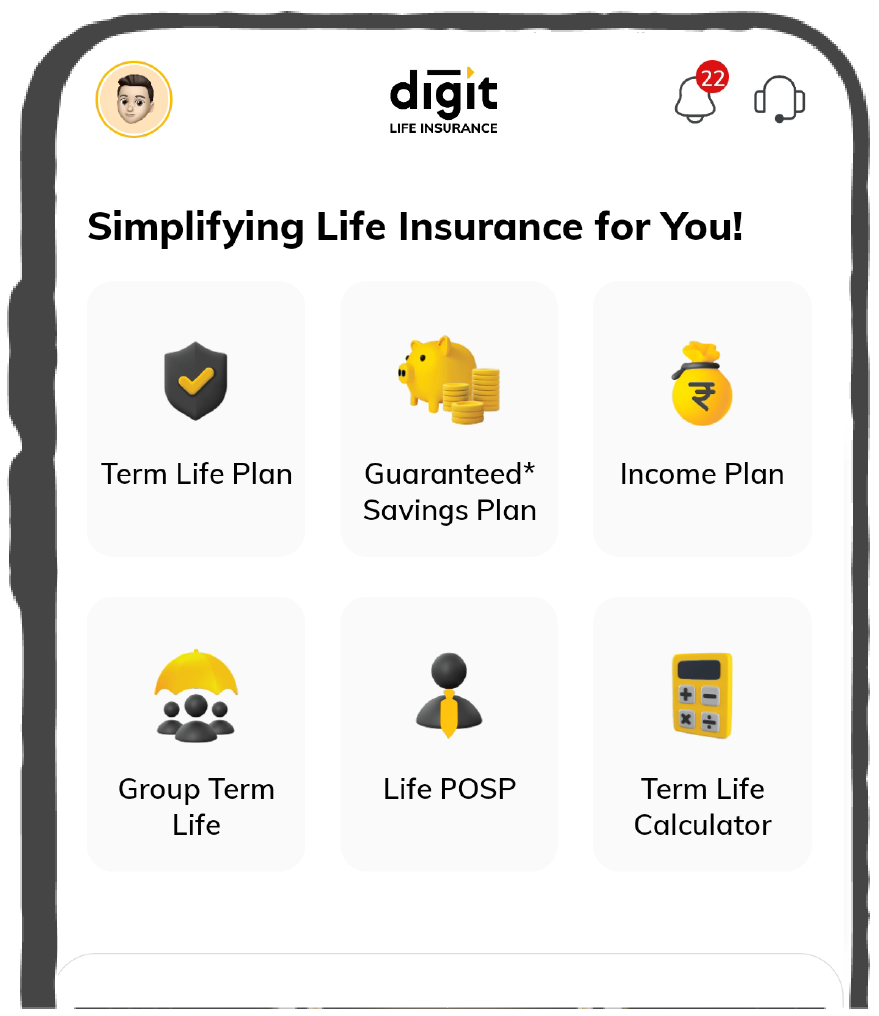Income Tax on Term Insurance Claim Amount & the Tax Rates in 2025

When dealing with the loss of a loved one, understanding the tax implications of a term insurance claim shouldn’t add to your stress. This comprehensive guide will help you understand exactly how income tax applies to term insurance claim amounts in simple, clear terms.
We will walk you through everything from basic tax rules to specific scenarios, helping you make informed decisions about your term insurance claims.

Table of Contents

What is Term Insurance Claim Amount?
A term insurance claim amount refers to the sum of money paid by an insurance company to the nominee mentioned in the policy document upon the death of the insured. This ensures financial security for the policyholder’s family.
While term insurance primarily provides coverage in case of death, some policies, known as return-of-premium (ROP) policies, return the premium paid at the end of the term if the insured survives.
However, for a claim to be honoured, it must fall within the terms and conditions of the policy. Claims can be rejected if they fail to meet certain conditions. Therefore its essential for the policyholder or nominee to verify policy details before filing a claim.
Who Can Claim?
- The nominee after the insured person’s death.
- The policyholder, upon maturity, if it's a Return of Premium policy.
Sometimes, claim amounts may be taxable, and understanding the tax implications can result in potential savings. Let’s explore the relevant provisions of the Income Tax Act and how they affect term insurance payouts.
When are Term Insurance Claims Tax-Free?
When the Claim Amount is Paid as Death Benefit
The most common scenario in which a term insurance claim is entirely tax-free is when it’s paid as a death benefit. If the policyholder passes away during the policy term, the insurance company disburses the sum assured to the beneficiary under Section 10(10D) of the Income Tax Act. In such cases, the entire claim amount is exempt from tax for the beneficiary.
The following are key points that make term insurance death claims tax-free:
- There is no cap on the tax-free amount for death benefits. The entire amount remains exempt if the sum assured is INR 10 lakh or INR 1 crore.
- If the term insurance includes riders like accidental death benefits, any claim amount received under such riders is also tax-free under Section 10(10D).
This section applies only when the claim is due to the policyholder’s death. It doesn’t cover any maturity benefits or survival benefits, although traditional term insurance policies typically lack such benefits.
When the Claim Amount is Paid Under Rider Benefits
Term insurance often includes optional riders like accidental death benefits or critical illness coverage. In most cases, claims made under these riders are tax-exempt under Section 10(10D), provided they qualify as death benefits. Here's how the taxation rules work for these riders:
- If a claim is made under a rider that provides a death benefit (like accidental death), it is generally tax-exempt. This means you won’t have to pay taxes on the money you receive.
- Some riders, like critical illness or disability benefits, may not be linked to the policyholder's death. Even though they are paid out while the person is alive, they can still be tax-exempt if they are designed properly according to the policy.
It’s essential to read the terms of your policy carefully to understand how the riders work and how they relate to tax rules, particularly Section 10(10D).
Tax Implications for Non-Resident Beneficiaries
Tax treatment can vary if the beneficiary of a term insurance claim is an NRI or a foreign national. While Section 10(10D) provides tax exemption for death benefits in India, for NRIs and foreign nationals, there may be additional reporting requirements depending on the tax laws of their country of residence.
For example, NRIs residing in the United States may have to disclose the amount received from a life insurance policy to the Internal Revenue Service (IRS) as part of their annual tax return.
Double Taxation Avoidance Agreements (DTAAs) between India and other countries may prevent the taxation of the claim amount in both countries. These agreements are designed to prevent residents from being taxed twice on the same income in both India and their country of residence. Still, the beneficiary should consult a tax professional for specific guidance on international tax compliance.
Terms and Conditions:
To ensure that the death benefit remains tax-free, certain conditions must be met:
- The policy must be a genuine life insurance policy, not a mere investment scheme.
- The annual premium paid towards the policy should not exceed 10% of the sum assured.
- The policy term should be for a minimum of 12 years.
Understanding Tax on Term Insurance Claim Amounts Scenarios with Illustration
Tip: Use a term insurance calculator to estimate the right sum assured and premium balance to ensure your policy remains tax-efficient under Section 10(10D).
Disclaimer: The above illustration is a hypothetical example created for educational purposes only and does not represent a real-life scenario. Please read your policy documents to understand the terms and conditions clearly.
When is the Term Insurance Claim Amount Taxable?
Policies Where Premium Paid Exceeds Permitted Limit
If the premium paid on a term insurance policy exceeds 10% or 20% of the sum assured, the death benefit may not qualify for exemption under Section 10(10D). In such cases, the payout will be added to the nominee’s income and taxed as per their income slab rate.
Example: A term policy with a sum assured of ₹10 lakh issued in 2018, where the annual premium is ₹1.5 lakh (15% of the sum assured), may result in a taxable payout. Since 15% exceeds the 10% threshold, the claim amount may be subject to tax.
Survival Benefits and Term Insurance
While most term insurance policies do not have survival or maturity benefits, some modern policies include a “Return of Premium” (ROP) feature. In these cases, if the policyholder survives the policy term, they receive a portion of the premiums paid.
As per current tax laws, the maturity proceeds may be taxable if the annual premium exceeds 10% of the sum assured. However, the proceeds are generally tax-free if the premium is within this limit.
Example: Suppose you purchase a sum assured of ₹10 lakh with an ROP term insurance policy with a term of 20 years and pay an annual premium of ₹10,000. If you survive the policy term, the insurer will return the total premiums paid, which would be ₹2,00,000 (₹10,000 x 20 years). However, this amount is more than 10% which will be subject to tax based on the prevailing tax rules.
Other Situations That Could Trigger Taxation
Although rare, there are instances where a claim amount might become taxable. Here are a few examples:
- If the term insurance policy is used as collateral for a loan, and the insurance payout is directed to the lender, there might be tax implications depending on how the claim is structured.
- When a company takes out a term policy on a key employee (often called “keyman insurance”), the claim amount received by the company could be subject to taxation. Corporate-owned policies may follow different tax rules than individual policies.
Documents Required for Tax-Free Claims
Maintaining relevant documentation is essential for beneficiaries to safeguard their claim’s tax-free status, which includes:
These documents are essential for both filing the claim and later reference. They help prove the claim is exempt from tax under Section 10(10D) should the tax authorities require verification.
Steps for Reporting and Filing Term Insurance Claim Amount
Step 1
Ensure you have received the term insurance claim amount from the insurer.
Step 2
Gather all relevant documents, including the claim settlement letter from the insurance company.
Step 3
Access the official income tax e-filing portal using your credentials.
Step 4
In the ITR form, locate the ‘Exempt Income’ section and enter the term insurance claim amount, specifying it as “Term Insurance Claim under Section 10(10D).”
Step 5
Review all the details entered in the ITR form for accuracy and submit the form.
Step 6
Complete the e-verification process using Aadhaar OTP or net banking.
Factors Affecting the Taxability of Term Insurance Claim Amount
1. Type of Beneficiary
The tax-free status often applies when the beneficiary is an individual (spouse, children). If the policy is owned by a business (Keyman Insurance), the payout may be taxable.2. Policy Ownership
If the insured is also the policy owner, the claim amount typically passes tax-free to the beneficiary. However, complexities can arise if the policy ownership is transferred for valuable consideration, which might bring the transfer-for-value rule into play, potentially making the claim amount taxable.3. Premium Payment Method
How premiums are paid can also impact the taxability. Premiums paid with after-tax dollars generally result in a tax-free death benefit. In contrast, the death benefit might be subject to taxes if premiums are paid with pre-tax dollars or the policy is considered a Modified Endowment Contract (MEC).4. Estate Inclusion
If the insured owns the policy at death and it passes to their estate, the payout could be subject to estate tax.5. Interest Component
If the claim amount is paid out over time, generating interest, the initial sum assured might be tax-free, but the interest generated over time could be taxable.6. Exclusions and Riders
Certain policy exclusions or riders, like an accidental death benefit rider, may affect the taxability of the payout.How to Minimize Tax on the Claim Amount?
Choose the Right Policy
When purchasing a term insurance policy, ensure that the premium is within the limit specified under Section 10(10D) concerning the sum assured. This ensures that the death benefit received by your nominees is exempt from tax.Consider Splitting High Premium Policies
If your term insurance premium is high due to a large sum assured, consider splitting the policy into multiple policies with smaller sum assured amounts. This can help keep the premium for each policy within the 10% limit, ensuring the death benefit from each policy remains tax-exempt.Regular Review and Update
Tax laws and regulations can change. Regularly review your term insurance policies and stay updated with the latest tax laws to ensure you are maximizing your tax benefits.Allocate Damages Carefully
If you are receiving a settlement, try to allocate as much of the amount as possible to non-taxable categories like physical injuries and medical expenses. This can reduce the portion of the settlement that is subject to taxes.Use Tax-Advantaged Accounts
Contributing to retirement accounts (like a 401(k) or IRA) or health savings accounts (HSAs) can reduce your taxable income.Consider a Structured Settlement
Instead of receiving a lump sum, you might opt for a structured settlement, which spreads payments over time. This can help manage your tax liability more effectively.Seek Professional Advice
Tax planning can be complex, especially when it involves multiple financial products. Consulting with a tax professional or financial advisor can provide personalized advice tailored to your financial situation, helping you make informed decisions about your term insurance and tax planning strategy.FAQs about the Income Tax on Term Insurance Claim Amount
Is it essential to pay GST on term insurance claim amount under Section 80C of the Income Tax Act?
Can you enjoy tax benefits on discontinuing the term insurance policy?
Who can be the nominee for a term insurance policy?
Which health-related add-ons are applicable under section 80D?
Is a term insurance claim amount taxable?
When Is Term Insurance Claim Amount Not Taxable?
If I receive the death benefit in instalments, is it taxable?
Can the death claim from a term insurance policy be taxable under any conditions?
Is the death benefit taxable if the policyholder dies due to suicide within the first policy year?
Are insurance proceeds from foreign-term insurance policies taxable in India?
How much term insurance can be claimed tax-free?
What happens if the claim amount exceeds a certain limit?
Is TDS (Tax Deducted at Source) applied on term insurance claims?
How can I ensure the claim amount remains tax-free?
Are riders with critical illness or accidental death benefits tax-deductible?
Should you buy a term plan just for the tax benefits?
Can you get term insurance tax benefits if you stop paying the premiums?
What happens if you don’t pay the premium on time?
Are premiums paid for term insurance tax-deductible?
What is the deduction limit for senior citizens under Section 80D?
What is the deduction limit for ordinary citizens under Section 80D?
Can I claim deductions under both Section 80D and Section 80C?
Are there any situations when the beneficiary might still have to pay tax?
Generally, the death benefit received by the beneficiary from a life insurance plan is tax-free under Section 10(10D) of the Income Tax Act, 1961. However, there are some exceptions where the benefits might be taxed:
- Benefits received under Section 80DD(3) are taxable.
- Benefits received from a Keyman insurance policy are also taxable.
If I get a term claim after my spouse's death, will I be taxed like health insurance maturity or a savings plan?
Other Important Term Insurance Guides
Other Important Articles Related to Term Insurance
Latest News
Read More










